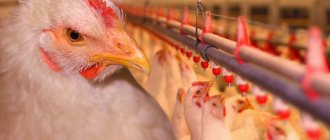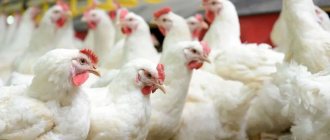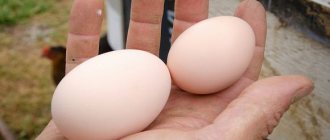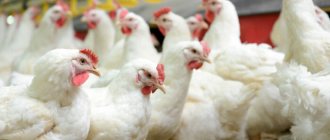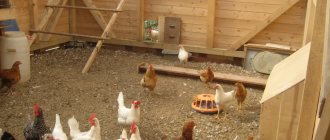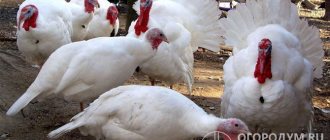Breeding chickens is a profitable business. When properly organized, it shows its effectiveness both on farms and on personal farmsteads. One of the key conditions for high profitability is a balanced and nutritious diet for birds. The health and productivity of the entire livestock directly depend on it. Depending on the size of the enterprise and the availability of your own feed supply, chickens can be given purchased or independently prepared mixtures. The main thing is to provide the chicks with enough calories and nutrients.
- Features of broiler breeds Pros and cons of broiler breeds
- Diet of broiler chickens in the first days of life
Pros and cons of broiler breeds
| Advantages | Flaws |
|
|
Appearance
Broiler chickens compare favorably with chicks of the same age of conventional breeds. The first ones, by the age of one and a half weeks, are able to gain up to 1.5 kilograms of live weight, while ordinary chickens gain no more than half a kilogram. The weight of an adult chicken of hybrid breeds reaches 4 kilograms, and the weight of some cockerels is 5.5.
Broiler chickens have a rather compact body, short legs and wings. The bird is inactive, has a calm disposition and a phlegmatic character. The color is most often white, like the plumage of the parents.
Conditions of detention
Despite the unpretentiousness of broilers, to increase productivity it is necessary to create a certain microclimate in the poultry house. The room should be pre-disinfected and heating devices should be installed in it during the cold season. Birds need stable, dim lighting with breaks at night, as they eat less well in the dark.
Feeders and drinkers should be placed in sufficient quantities so that chickens always have free access to them. In addition, it is necessary to maintain air humidity at 55–65% and regularly update the litter.
What you need to know about breeding?
There are two ways of breeding broiler chickens - intensive and extensive:
- Intensive (production) housing consists of limiting the movement of broiler chickens from the moment of hatching in a cage or deep floor litter and feeding the chickens with complete dry feed.
- With the extensive method of rearing, which is most suitable for a peasant or farm enterprise, the poultry is kept in equipped chicken coops and cages, moves freely around the range, and receives a variety of feed types and composition.
When keeping birds “free”, a poultry house is equipped. Day-old chicks and commercial poultry require space at the rate of 12-15 birds per 1 m².
With cage rearing, up to 18 broilers are placed per 1 m², but the meat of such birds will be denser and tougher. There are several options for cells that are made independently or purchased ready-made. Cells are assembled into structures similar to cassettes or batteries.
Most private poultry farmers prefer the floor method of growing in a chicken coop on litter.
To do this, the floors are covered with sawdust, straw, shavings, and fibrous peat. To comply with sanitary and hygienic standards, damp lumps are regularly removed, mixed and filler is added.
In the summer, growing broiler chicks and adult chickens are released outside into a fenced paddock. If the walk is well protected from drafts, for example, by previously used window or greenhouse frames, the chicks are released onto the “grass” from the age of one month.
Temperature
Broiler chickens require strict adherence to temperature and humidity in the areas where they are kept. Humidity throughout the growing period should be between 60-70%.
For heating, household and industrial heaters and infrared lamps are used.
Day-old chicks are fenced off, limiting their distance from the heat source, maintaining a temperature of + 32°-35°C. From the second week, a gradual decrease in temperature begins. 6-10 day old chicks require t + 32°-30°C. 11-20 days - t + 28°-26°С. Starting from the third week, t +24-20°C is required.
Important! Chickens up to 2-3 weeks of age have an underdeveloped digestive system; they are not able to independently maintain optimal body temperature.
To prevent hypothermia of the abdomen and colds, it is necessary not only to maintain the temperature regime, but also to warm the bedding.
Lighting
Until the 5th day, the coop is illuminated for 20-24 hours. At a week of age, when the chicks begin to distinguish between day and night, they begin to interrupt the lighting for 10-15 minutes every 2 hours, gradually increasing the daylight hours to 16-17 hours.
Ventilation
The poultry house must be equipped with ventilation and exhaust hood. A constant supply of clean air is vital for broilers.
Feeders and drinkers
Before reaching a week of age, the feeder is filled to the brim. As soon as the chicks acquire the skills of self-feeding, feeders and drinkers are filled ¼ full and raised above floor level to avoid contamination of the litter with food.
Raising broiler chickens is profitable. By following simple requirements, you can not only provide your family with environmentally friendly, dietary chicken meat, but also achieve a small profit when selling broiler meat.
Requirements for arranging a chicken coop
To increase the survival rate of the population, chicks in the first days of life and grown young animals should be kept in different rooms. The hatched chicks are kept in the brooder for 10 days. It is necessary to maintain a stable temperature regime in it, ensure constant air ventilation, but avoid drafts. The placement rate does not exceed 18 chickens per 1 m². The lighting intensity in the brooder should be at least 1.8 W/m².
On day 11, the chicks are transferred to a common chicken coop. In large farms they are placed on the floor or multi-tiered racks in cages designed for a total weight of up to 40 kg. At home, the construction of complex structures is unjustified, so chickens move freely around the poultry house. It is recommended to equip the room with supply and exhaust ventilation. If you plan to breed broilers seasonally (only in spring and summer), you can place the young animals in an unheated room. When growing year-round, it is necessary to insulate the chicken coop in advance and take care of the heating system.
Disease Prevention
Raising broilers is quite a troublesome business. In order to avoid diseases to which chickens are highly susceptible, a set of preventive measures is used:
- From birth to 5 days, chicks are fed antibacterial drugs.
- Before day 10, individuals are fortified.
- On the 11th day - vaccination against Gumboro disease.
- From 12 to 16 days – vitaminization again.
- On day 18, re-vaccination against Gumboro disease.
- On the 19th day – vitaminization.
- From 21 to 23 days, preventive work against coccidiosis is carried out.
- Vitaminization continues until day 28.
The given scheme of preventive measures is a minimum program. But for those who raise large numbers of chickens for sale, this is not enough. Additional activities required:
- From 15 to 17 days - drinking drugs to increase immunity against hypovitaminosis and vitamin deficiency.
- Day 24 – additional vaccination against Gumboro disease.
- Day 27 – vaccination against Newcastle disease.
- From 28 to 32 days - drinking water and supplementing the food against hypovitaminosis and vitamin deficiency and increasing immunity.
Broiler poultry has very low immunity, and if it has contracted a virus or infection (and in recent years they have become more and more aggressive), it is almost impossible to cure it and bring it to the required weight limit.
Choosing the optimal breed
Almost all broiler crosses are the result of hybridization of highly productive meat chickens. They have a strong skeleton and in most cases white plumage. The average daily weight gain of chickens is 80 g. The most productive broiler breeds include:
- ROSS-308 and 708;
- COBB-500;
- Hubbard F-15;
- Gibro-6;
- Broiler-61.
Among owners of private farms, birds from the Smena line are very popular. When choosing a specific breed, it is recommended to focus on its productivity indicators, adaptability to the climate of your region and the cost of chickens.
Feeding system
The productivity of broilers primarily depends on the calorie content and balance of their diet. The immunity of chicks is established in the first days of life. A nutritious diet that takes into account the age characteristics of chickens reduces the risk of the spread of coccidiosis and other infectious diseases that cause mass death of livestock. The feed must contain all the substances necessary for active growth: proteins, carbohydrates, vitamins, micro- and macroelements. Feed mixtures for broilers are prepared from products of plant and animal origin:
- grains (corn, oats, wheat, barley and their bran);
- legumes (soybean and pea meal);
- oilseeds (sunflower cake);
- vegetables (potatoes, carrots, onions, beets, pumpkins);
- herbal flour;
- eggs;
- whey;
- return;
- meat and bone, blood and fish meal;
- hydrolysis yeast.
You can prepare chicken feed yourself or buy age-appropriate formulations. The latter contain in processed form all the components necessary for broilers and are well absorbed. When preparing the food yourself, you will have to additionally enrich it with protein, vitamin and mineral supplements and coccidiostats.
Diet of broiler chickens in the first days of life
Hatched chicks are given crushed boiled egg yolks and warm boiled water for 6–12 hours. The breaks between feedings are 3 hours. The next day, the egg can be mixed with low-fat cottage cheese in a 1:1 ratio. Starting from day 3, the following is gradually added to the mash:
- ground cooked corn, oats or wheat;
- vegetables;
- fresh herbs.
The digestive system of chickens of this age is not yet functioning well, so high fiber ingredients should not be included in their diet.
From day 5, chickens are given fat-soluble vitamins (A, E, D) and mineral supplements to prevent the development of rickets. The number of meals during this period is reduced to 6 times a day.
Important points
On industrial poultry farms, the main food for broilers is compound feed. On a homestead farm , without a thoughtful and varied diet, fattening chickens may not be justified. To monitor the growth of broilers, they need to be weighed weekly.
The first five days are a particularly important period for feeding the chicks. Their digestive system is not yet developed and the food must be easily digestible.
Lighting is of great importance for the development and growth of chickens . When exposed to light, their metabolism is activated. During the first half-month they need 24-hour lighting.
With proper organization, even in a small area in the summer (May–August), you can raise two batches of broiler chickens without much expense. Thus, you will be able to provide your family with dietary meat.
Diet of one month old broilers
From this age, young animals are prepared for slaughter and transferred to finishing feed. The number of meals is reduced to 3 times, while simultaneously increasing the calorie content of the diet and limiting the birds' movement. Serving size increases by 20 g every 2 weeks. Feed mixtures for broilers can contain coarse grain and granulated mixtures of large fractions. The composition of the products remains the same, but the ratio of components changes. The percentage of proteins decreases, and the amount of carbohydrates increases.
2 weeks before slaughter, fish and its processed products are excluded from the chicken diet. If this is not done, the quality of the finished product will deteriorate due to an unpleasant specific odor. The last feeding is carried out 6-10 hours before slaughter. Fasting is necessary so that the food eaten has time to be digested and does not affect the taste of the meat.
How to properly introduce compound feed?
Broiler chickens quickly adapt to new products. Therefore, they can be given compound feed already in the first week of life. Chicks require a special pre-start composition. At first, the feed is introduced in small quantities, and by the end of the week it completely replaces the egg.
After this, the chickens are gradually transferred to starter mixtures. The majority of the diet of one-month-old broilers consists of grain-based feed. Before slaughter, the birds are transferred to a finishing feed mixture.
For breeders who combine the breeding of broilers with the cultivation of various feed crops, it is more profitable to use their own raw materials than to buy ready-made mixtures. However, in this case there is a possibility of nutritional deficiency in the chickens' diet. To compensate for it, it is advisable to use special feed additives that contain proteins, vitamins, minerals, and enzymes in concentrated form.
Keeping Birds Healthy
To prevent rickets, coccidiosis and other dangerous diseases, vitamin and mineral supplements and coccidiostats are included in the diet of growing chickens. To reduce the risk of the spread of intestinal disorders, it is important to keep feeders and drinkers clean. Additionally, it is recommended to feed the chicks from days 5 to 7 with a weak solution of potassium permanganate.
Sick chickens are quarantined so that they do not come into contact with healthy individuals. Pharmaceuticals, including antibiotics, should only be given after consultation with a veterinarian. They are not used at the final stage of fattening to prevent medications from getting into the meat.
Due to the sudden weight gain in broilers, the load on the skeleton increases greatly, so they need more vitamins and minerals. You can introduce each component separately or use complex supplements that include the required set of biologically active substances (BAS).
Diseases
Due to weak immunity, cross-breeds are more susceptible to various diseases. To prevent the death of livestock, it is important to vaccinate, monitor the cleanliness of the chicken coop, and promptly isolate lethargic and stunted individuals.
What diseases are at risk:
- Arthritis. Rapid weight gain causes joint problems. An additional reason for the development is poor motor activity. The symptom is “falling on your feet.” The disease can be treated with ampicillin.
- Heteracidosis. The causative agent is intestinal helminths. You can get rid of them with Piperazine.
- Ascites is an abundance of fatty tissue in the abdomen. The reason for the development is poor nutrition. Prevention of the disease consists of increasing the percentage of fresh greens in the food.
- Newcastle disease (or pseudoplague). An infectious disease that can kill an entire herd in a couple of days. Individuals develop discharge from the beak, the temperature rises, and the feathers have a ruffled appearance. The disease has no cure; the only preventative measure is vaccination.
- Marek's disease. The central system is damaged. Crosses lose coordination and experience convulsions. At risk are individuals from 3 weeks to 5 months. Prevention – vaccination (procedure effectiveness 95%).
Mistakes of novice breeders
Although raising broilers does not present any particular difficulties, inexperienced owners do not always provide the chickens with normal living conditions. This leads to a decrease in productivity, and in some cases, to the death of birds. Common mistakes include:
| Failure to comply with temperature conditions | In an insufficiently warm room, chickens' immunity decreases. Exceeding the temperature norm causes lethargy and loss of appetite in birds. |
| Excessive humidity | Leads to the appearance of fungus and promotes the spread of pathogenic microorganisms. |
| Insufficient hygiene | Dirty feeders and bedding cause intestinal infections and intoxication with ammonia compounds. |
| Ignoring veterinarian recommendations | Saving on veterinary care can lead to significantly greater financial losses in the event of late or incorrectly selected treatment. |
Useful tips from
There are various techniques for stimulating appetite in broilers:
- As the chicks grow, the size of the feeder should increase. It is optimal if the height corresponds to the level of the chickens’ backs. The container must be made of durable food-grade plastic that can be washed with disinfectant solutions.
- The amount of food for each meal is calculated taking into account the rate of consumption of the previous portion. If it is less than half an hour, the volume of the mixture is increased. If the birds do not have time to eat the food in 45 minutes. and more, the portion needs to be reduced.
- It is better to give granular formulations to chickens from one month of age. They are more hygienic and better digestible because the bird cannot choose the tasty bits from them.
- The optimal mode of alternating light and darkness for broilers is 4/2 hours. In this case, they eat more and gain weight faster.
- On a large farm, it is convenient to use automatic feeding systems, in which food is supplied through a conveyor at certain intervals.
Purchased feed has a number of advantages over self-prepared mixtures. Large manufacturers are responsible for the quality of their products. Their feed complies with GOST and has been certified. A large number of ingredients in the mixtures make it possible to fully meet the nutritional needs of broilers.
In our company you can order compound feed and BVMD for meat chickens of any age. We produce:
- starting compositions for 0-2 and 3-4 weeks;
- and finishing feeds for chickens from 5 weeks and older.
High quality of incoming raw materials, accurate dosage and high-quality mixing of components make our products useful and safe.
Where should you buy?
There are not many places where chicks are purchased for home breeding. Moreover, sometimes you have to bring them from another region. Prices depend on age and breed. The deal should be concluded directly with the breeder. The intermediary will not only inflate the price by 2-3 times, but it is also unknown how the bird will be transported and what they will feed it.
The health of chickens depends on favorable breeding conditions. When kept and transported in damp, dirty and cramped spaces, the risk of infection with various diseases increases greatly. By the age of 10 days, an experienced breeder will have completed at least 7 vaccinations, including against mycoplasmosis and bacterial infections, to prevent stress and infectious bronchitis in chickens.
Purchasing chickens at the market
The only advantage of buying young chicken at the nearest market is its availability. There is no need to travel far and provide special transportation. But then the downsides begin:
- It is difficult for a non-professional to understand that it is a broiler in front of him; they can slip any chicken;
- the actual conditions of breeding and maintenance are unknown;
- lack of vaccinations;
- there is a high probability of death of the entire bird population from unknown causes.
Buying on the market is possible only in one case, if the private person has a regular poultry trade, is a breeder and a trusted supplier. First, you will have to come to the place for information: meet the seller and find out the delivery time of the brood. If the conditions are suitable, make a reservation.
The worst option is to purchase chickens at the poultry market, from the first seller you come across.
Purchase at a poultry farm
Poultry farms are becoming the most reliable source of supply of young animals to farmers and individuals. They guarantee that you can purchase not just a bird that is healthy in all respects, but also a bird of the declared breed. The price for such chicks is quite high. If the factory significantly underestimates the cost (to below market value), then most likely it is a rejected bird. Such an acquisition carries significant risks.
If you decide to make a purchase at a poultry farm, two points are taken into account:
- Factories do not raise chickens by simply crossing different breeds. The so-called autosex cross is practiced here - this is the most highly productive technology for obtaining and preserving meat breeds of chickens. At the same time, day-old chicks differ in hens and cockerels by contrasting color: some are white, others are brown.
- Finding a suitable poultry farm is not easy - there are not many of those that breed and sell broilers throughout the country. Most of them specialize in the supply of eggs. And ordinary chickens, in most cases of the meat and egg line, are sold under the guise of meat breeds.
When concluding a purchase agreement with a poultry farm, you should inquire about documentary evidence that it has a license to breed and sell broiler chicken breeds. Next, an order is made, payment is made, and the chickens are taken out at the appointed time.
Hatchery
The most economical and reliable way to purchase a suitable breed of chickens is incubation stations. They thoroughly monitor both the breed and the health of the chicks, but such a purchase has its drawbacks:
- The batches are too small, usually they are all reserved long before the chicks appear, even at the egg-laying stage.
- It's difficult to find such a station.
Another way to acquire purebred young animals is to contact private owners of their own incubator. Then take the following steps:
- find a private person with his own incubator;
- choose a poultry farm that specializes in breeding meat poultry;
- purchase a batch of breeding eggs;
- transported to a private incubator, laid for 22 days;
- After the designated time, the chicks are taken away.
In this option, it is important to ensure the transportation of eggs and hatched chicks.
Large stationary incubators are used for hatching large populations. But if a novice summer resident or the owner of a small plot is engaged in poultry farming, they purchase a small home apparatus.
